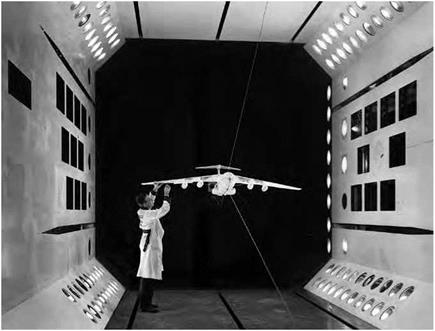Unlocking the Mysteries of Flutter: Langley’s Transonic Dynamics Tunnel
The example of the Langley Transonic Dynamics Tunnel (TDT) illustrates how the NACA and NASA took an unsatisfactory tunnel and converted it into one capable of contributing to longstanding aerospace research. The Transonic Dynamics Tunnel began operations as the 19-Foot Pressure Tunnel in June 1939. The NACA design team, which included Smith J. DeFrance and John F. Parsons, wanted to address continued problems with scale effects. Their solution resulted in the first large-scale high-pressure tunnel. Primarily, the tunnel was to evaluate propellers and wings at high Reynolds numbers. Researchers were to use it to study the stability and control characteristics of aircraft models as well. Only able to generate a speed of 330 mph in the closed-throat test section, the NACA shifted the high-speed propeller work to another new facility, the 500 mph 16-Foot High-Speed Tunnel. The slower 19-Foot Pressure Tunnel pressed on in the utilitarian work of testing models at high Reynolds numbers.[572]
Dissatisfied with the performance of the 19-Foot Pressure Tunnel, the NACA converted it into a closed-circuit, continual flow, variable pressure Mach 1.2 wind tunnel to evaluate such dynamic flight characteristics as aeroelasticity, flutter, buffeting, vortex shedding, and gust loads. From 1955 to 1959, the conversion involved the installation of new components, including a slotted test section, mounts, a quick-stop drive system, an airflow oscillator (or "gust maker”), and a system that
generated natural air or a refrigerant (Freon-12 and later R-134a) test medium. The use of gas improved full-scale aircraft simulation.[573] It produced higher Reynolds numbers, eased fabrication of scaled models, reduced tunnel power requirements, and, in the case of rotary wing models, reduced model power requirements.[574]
After 8 years of design, calibration, and conversion, the TDT became the world’s first aeroelastic testing tunnel, becoming operational in 1960. The tunnel was ready for its first challenge: the mysterious crashes of the first American turboprop airliner, the Lockheed L-188 Electra II. The Electra entered commercial service with American Airlines in December 1958. Powered by 4 Allison 501 turboprop engines, the $2.4-million Electra carried approximately 100 passengers while cruising at 400 mph. On September 29, 1959, Braniff Airways Flight 542 crashed near Buffalo, TX, with the loss of all 34 people aboard the new Electra airliner. A witness saw what appeared to be lightning followed by a ball of fire and a shrieking explosion. The 2.5- by 1-mile debris field included the left wing, which settled over a mile away from the main wreckage. The initial Civil Aeronautics Board crash investigation revealed that failure of the left wing about a foot from the fuselage in flight led to the destruction of the airplane.[575]
There was no indication of the exact cause of the wing failure. The prevailing theories were sabotage or pilot and crew error. The crash of a Northwest Orient Airlines Electra near Tell City, IN, on March 17, 1960, with a loss of 63 people provided an important clue. The right wing landed 2 miles from the crash site. Federal and Lockheed investigators believed that violent flutter ripped the wings off both Electras, but they did not know the specific cause.[576]
|
A Lockheed C-141 model undergoing evaluation in the Transonic Dynamics Tunnel (TDT). NASA. |
The future of the new American jet airliner fleet was a stake. While the tragic story of the Electra unfolded, the Langley Transonic Dynamics Tunnel became operational in early 1960. NASA quickly prepared a one-eighth-scale model of an Electra that featured rotating propellers, simulated fuel load changes, and different engine-mount structural configurations. Those features would be important to the wind tunnel tests because a Lockheed engineer believed that the Electra experienced propeller-whirl flutter, a phenomenon stimulated by engine gyroscopic torques, propeller forces and moments, and the aerodynamic loads acting on the wings. Basically, a design flaw, weakened engine mounts, allowed the engine nacelles and the wings to oscillate at the same frequency, which led to catastrophic failure. Reinforced engine mounts ensured that the Electra continued operations through the 1960s and 1970s.[577]
Flutter has been a consistent problem for aircraft since the 1960s, and the Transonic Dynamics Tunnel contributed to the refinement of many aircraft, including frontline military transports and fighters.
The Lockheed C-141 Starlifter transport experienced tail flutter in its original configuration. The horizontal tail of the McDonnell-Douglas F-15 Eagle all-weather air superiority fighter-bomber fluttered.[578] The inclusion of air-to-air and air-to-ground missiles, bombs, electronic countermeasures pods, and fuel tanks produced wing flutter on the General Dynamics F-16 Fighting Falcon lightweight fighter. NASA and General Dynamics underwent a combined computational, wind tunnel, and flight program from June 1975 to March 1977. The TDT tests sought to minimize expensive flight-testing. They verified analytical methods in determining flutter and determined practical operational methods in which portions of fuel tanks needed to be emptied first to delay the onset of flutter.[579]
The TDT offered versatility beyond the investigation of flutter on fixed wing aircraft. Tunnel personnel also conducted performance, load, and stability tests of helicopter and tilt rotor configurations. Researchers in the space program used the tunnel to determine the effects of ground – wind loads on launch vehicles. Whether it is for a fixed or rotary wing airplane or a spacecraft, the TDT was used to evaluate the effect of wind gusts on flying vehicles.[580]











